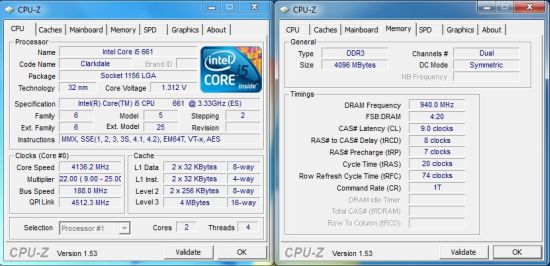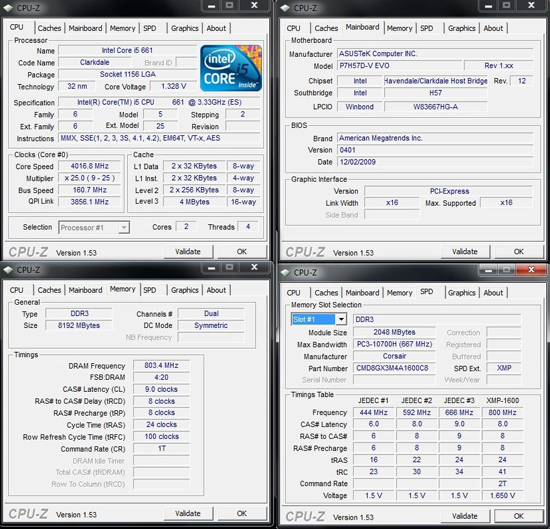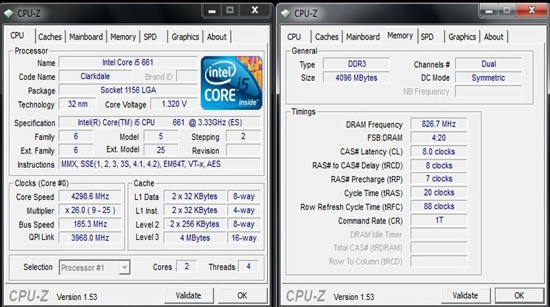Choosing the Best H55/H57 Motherboard - Part 1
by Rajinder Gill on January 31, 2010 11:30 PM EST- Posted in
- Motherboards
Overclocking - Dissent in the Ranks
Ok, let's start off with a discrete GPU. When using 4GB configurations, the best board of the bunch appears to be the ASRock.

It's the only board that manages this speed fully stable with our Corsair Dominator kit. This is surprising considering the ASRock board has the least overclocking centric BIOS of the boards we have on test today. Voltage scales are fairly coarse in stepping, and memory sub-timing options are limited together with control over the QPI multiplier, but this does not seem to affect the board when it comes to 4GB memory configurations using the 2:10 memory ratio, even when using "lesser" performance modules.
The H57 EVO manages to take the same components to around 182 BCLK while the MSI and ASUS H55 models reach their limits at around 175 BCLK - around 130MHz lower than the ASRock board for raw memory frequency.
8GB memory overclocking is a different story. The leader in this department is the most expensive board on test today, the ASUS H57M EVO:

ASUS' H57 offering pips the ASUS H55M EVO to the post with our 8GB Corsair memory kit. The H55 model manages around 1580MHz fully stable vs. 1600MHz stable on the H57.
The ASRock's limits come in around 1450~1500MHz because you don't get access to some of the sub-timings needed to run higher memory speeds fully stable when the DIMM slots are loaded with 8GB, nor do you get the option to lower the QPI multiplier. That lands you at frequencies that the IMC cannot handle when loaded heavily.
MSI's BIOS provides plenty of additional sub-timing options, although we could not find a combination of settings to help achieve what we managed on both of the ASUS boards using the same memory modules. The QPI ratio had to be dropped to accommodate, while memory sub-timings needed loosening to achieve full stability.
One thing worthy of mention here, S3 sleep resume will work on the ASUS H55/H57 EVO boards and the MSI board at 200BCLK and beyond if you use lower memory multiplier ratios and QPI multipliers. The ASRock H55M-Pro is limited to a maximum of 190 BCLK for sucessful S3 resume on current BIOS releases.
Overclocking with the IGP Active
This is where things become limited rather quickly when it comes to maximum stable BCLK frequency. Anything over 165 BCLK needs judicious amounts of IGP voltage to facilitate higher CPU core speeds, even if you don't overclock the IGP in tandem. Using our 661 sample CPU and retaining the stock 900MHz IGP frequency, a BCLK of 165 is possible on all four boards using the 2:10 memory ratio and the highest available QPI multiplier. Anything higher and we have to pump an extra 0.1V into the IGP to get to 175 BCLK.

One would think that using a lower the QPI multiplier and memory ratio would increase headroom somewhat, but it appears this is not the case. We tried all QPI multipliers in conjunction with the 2:8 and 2:6 memory ratios and could not find a combination that was stable enough to enter the OS over 175 BCLK. Whether or not this is down to vendors getting to grips with the platform or not is currently unknown to us, although it would not be surprising if that happens to be the case. Time will tell.
We've run out of time to explore every angle of IGP performance and QPI ratios in this article, but we will endeavor to cover this angle in a future article if need be. Right now, we'll say it appears that you're going to be BCLK limited south of 170 MHz with the IGP in tow. Subtract another 20MHz off that for 8GB configurations, and bear in mind that you'll need to use low memory speeds, capping you to a maximum of around DDR3-1333MHz with things in their current state.










56 Comments
View All Comments
randercol - Friday, March 26, 2010 - link
stop smoking and drinking guys and girls.its not wrote in any bible that our next generation will in future will take smoking and drinking.its our bad manners and we grow it very fast when we were small then we were alive without that things so why should now?http://www.goarticles.com/cgi-bin/showa.cgi?C=2236...">http://www.goarticles.com/cgi-bin/showa.cgi?C=2236...
alimaamoser - Tuesday, March 16, 2010 - link
i think 55 is best anand....http://www.articlesbase.com/health-articles/dentas...">http://www.articlesbase.com/health-arti...-does-de...
jed22281 - Friday, March 19, 2010 - link
looks like this users acct needs to be deleted for spammingrandercol - Monday, March 22, 2010 - link
i think 53 is best for you and it is the best for you .http://www.articlesbase.com/wellness-articles/ther...">http://www.articlesbase.com/wellness-ar...eanse-re...
alimaamoser - Tuesday, March 16, 2010 - link
i think 55 is best.......http://www.articlesbase.com/health-articles/dentas...">http://www.articlesbase.com/health-arti...-does-de...
dentasmile md
Nomale - Thursday, February 18, 2010 - link
Is there any difference with h57 and p55 regarding xeon support? I don't think it's supported officially since it's aimed at the server market, but since it's based on lynnfield there seem to be no problem with p55 at least.Mrkock - Wednesday, February 10, 2010 - link
The first time I read this article, I got the impression that the H55/H57 boards don't support a Pci16x Video card.The second time I read this article, I was pretty sure about it.
So is that true, that the H55/H57 can't support additional Video cards (like a Nvidia or ATI graphics card)?
Rajinder Gill - Thursday, February 11, 2010 - link
Hi,H55/H57 will support a single GPU only for Clarkdale processors (so any 8x or 16x PCI/e GPU is fine).
If you want to run dual GPU configurations you have to use a Lynnfield series CPU.
regards
Raja
jtsh0ck3r - Friday, February 5, 2010 - link
Raja,For someone looking to upgrade an old system with an older PS with just the 4-pin 12V ATX connector, should they upgrade the PS as well?
Rajinder Gill - Friday, February 5, 2010 - link
Hi,You should be fine on 4 pin with Clarkdale, unless you plan on very heavy overclocking. Load power draw is under 100 watts in most scenarios when you run these CPU's at stock (around 8~10 amps from the 12V connector).
Hope the helps
Raja